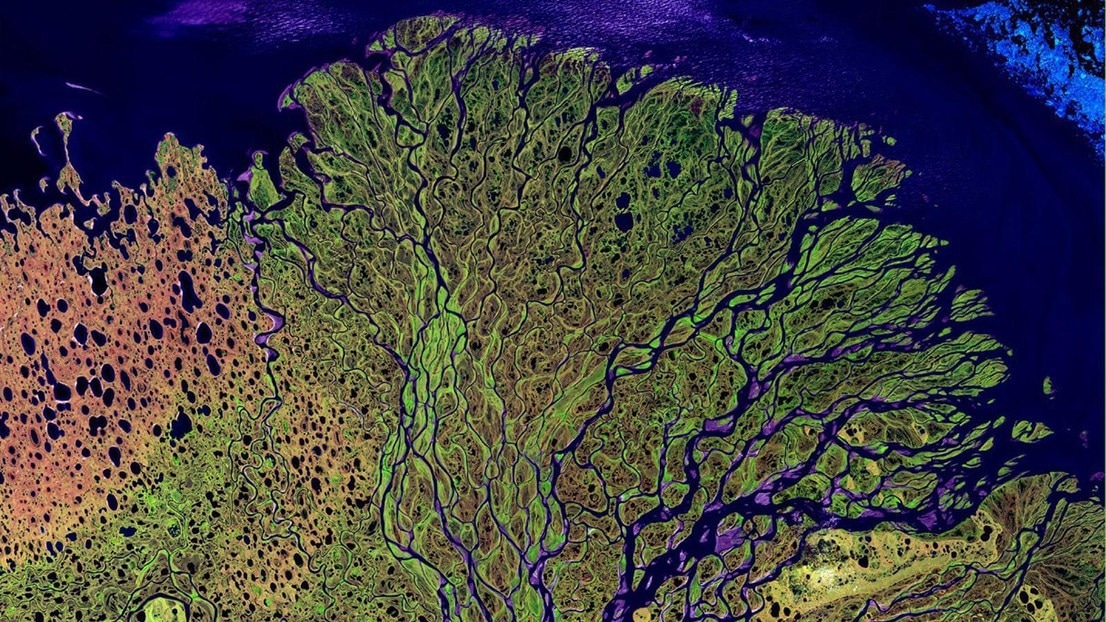Tom Battin, an EPFL professor, analyzes the existing knowledge of carbon fluxes in the world’s river networks in a recent journal article. He highlights the importance of rivers in the global carbon cycle and advocates for establishing a global River Observation System.
 A satellite image of Siberia Lena delta that flows in the Arctic Ocean. Image Credit: © NASA
A satellite image of Siberia Lena delta that flows in the Arctic Ocean. Image Credit: © NASA
Until now, understanding the global carbon cycle was mostly restricted to the oceans and terrestrial ecosystems. EPFL’s River Ecosystems Laboratory (RIVER) Head Tom Battin, has now shed new light on the vital role that river networks serve in the changing world. These findings are detailed in a review article commissioned by Nature.
Battin, a full professor at EPFL’s School of Architecture, Civil and Environmental Engineering (ENAC), convinced a dozen experts to contribute the article. For the first time, their investigation integrates land, atmosphere, and oceans to illustrate the crucial significance of river ecosystems for global carbon fluxes.
Calculating Carbon Fluxes
The investigators stress the significance of global river ecosystem metabolism in their study.
River ecosystems have a much more complex metabolism than the human body. They produce both oxygen and CO2 through the combined effect of microbial respiration and plant photosynthesis. It’s important to fully appreciate the underlying mechanisms so that we can evaluate and quantify the impact of the ecosystem metabolism on carbon fluxes.
Tom Battin, Full Professor, School of Architecture, Civil and Environmental Engineering, École polytechnique fédérale de Lausanne
“Understanding river ecosystem metabolism is an essential first step towards better measuring the carbon cycle since this metabolism determines the exchange of oxygen and greenhouse gases with the air. Scientists already have recent aggregate estimates for lakes, coastal environments, and the open oceans,” adds Pierre Regnier, a Professor at Université Libre de Bruxelles (ULB) and one of the contributing authors.
Our research adds the missing piece to the puzzle, paving the way to a comprehensive, integrated, quantified picture of this key process for our ‘blue planet.’
Pierre Regnier, Professor, Université Libre de Bruxelles
The researchers compiled global data on river ecosystem respiration and plant photosynthesis to achieve their conclusions.
The observations indicate a clear connection between river ecosystem metabolism and the global carbon cycle. River ecosystem metabolism uses up organic carbon derived from terrestrial ecosystems while routing water to the oceans, resulting in CO2 emissions into the atmosphere.
Residual organic carbon that has not been metabolized enters the oceans, along with CO2 that has not been emitted into the atmosphere. The biogeochemistry of the coastal waters may be influenced by these riverine carbon inputs.
Battin and his coworkers also analyzed how global change, specifically climate change, land use change, urbanization, and flow regulation, like dams, impact river ecosystem metabolism and associated greenhouse gas fluxes.
Rivers that drain agricultural lands, for example, receive huge amounts of nitrogen from fertilizers. Increased nitrogen concentrations, combined with rising temperatures due to global warming, can lead to eutrophication, which results in the formation of algal blooms.
As these algae die, they promote the production of methane and nitrous oxide, both of which are more potent greenhouse gases than CO2. Dams can also aggravate eutrophication, possibly increasing greenhouse gas emissions even further.
A New River Observation System
The researchers concluded by emphasizing the importance of establishing a global River Observing System (RIOS) to better quantify and predict rivers’ roles in the global carbon cycle. RIOS will combine data from river sensor networks and satellite imagery with mathematical models to produce near-real-time carbon fluxes associated with river ecosystem metabolism.
Thereby, RIOS would serve as a diagnostic tool, allowing us to ‘take the pulse’ of river ecosystems and respond to human disturbances. River networks are comparable to our vascular systems that we monitor for health purposes. It is time now to monitor the health of the world’s river networks.
Tom Battin, Full Professor, School of Architecture, Civil and Environmental Engineering, École polytechnique fédérale de Lausanne
Journal Reference:
Battin, T. J., et al. (2023) River ecosystem metabolism and carbon biogeochemistry in a changing world. Nature. doi.org/10.1038/s41586-022-05500-8.